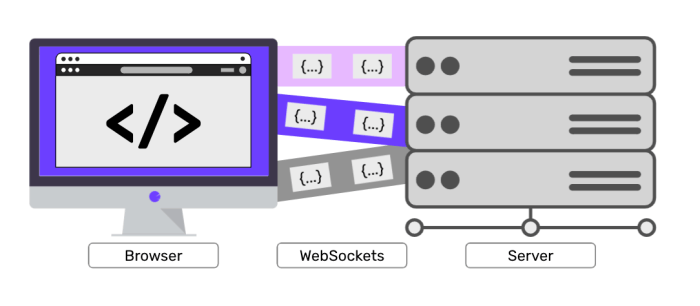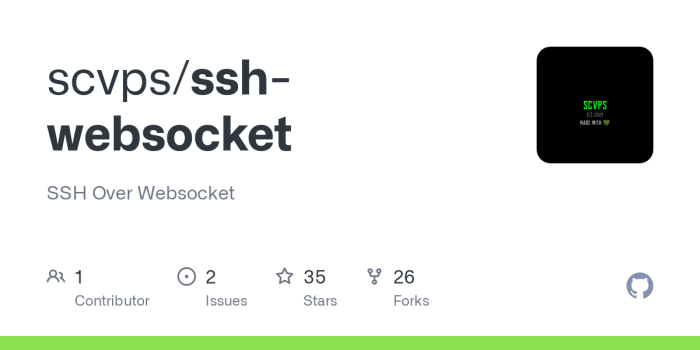SSH.SSHSlowdns.com – In the realm of remote access, SSH over WebSockets has emerged as a game-changer. By seamlessly integrating the secure shell (SSH) protocol with the ubiquitous WebSocket technology, SSH over WebSockets offers a plethora of advantages, including enhanced performance, reduced latency, and heightened security.
This comprehensive guide delves into the technical intricacies, real-world applications, and security considerations of SSH over WebSockets. Whether you’re a seasoned IT professional or a curious novice, this guide will provide you with a thorough understanding of this transformative technology.
Overview of SSH over WebSockets

SSH over WebSockets is a technique that allows you to establish a secure shell (SSH) connection over a WebSocket. This enables you to access and manage remote servers through a web browser or other WebSocket-compatible client.SSH over WebSockets provides several benefits, including:
- Cross-platform compatibility: WebSockets are supported by all major browsers and operating systems, making it easy to access remote servers from any device.
- Improved security: WebSockets provide an encrypted channel for data transmission, ensuring the security of your SSH connection.
- Enhanced flexibility: SSH over WebSockets allows you to connect to remote servers from behind firewalls and proxy servers, making it more flexible than traditional SSH connections.
SSH over WebSockets is particularly useful in scenarios where traditional SSH connections are not feasible, such as:
- Web-based administration: SSH over WebSockets enables you to manage remote servers from a web browser, providing a convenient and user-friendly interface.
- Remote access from untrusted networks: SSH over WebSockets allows you to securely access remote servers from public Wi-Fi networks or other untrusted environments.
- Integration with web applications: SSH over WebSockets can be integrated with web applications to provide secure access to remote resources, such as databases or file systems.
Technical Implementation
SSH over WebSockets is technically implemented by encapsulating SSH traffic within WebSocket frames. The WebSocket protocol provides a bidirectional, full-duplex communication channel over a single TCP connection. This allows SSH to be transported over HTTP-based networks, such as those used by web browsers.The
WebSocket protocol is responsible for establishing and maintaining the WebSocket connection, framing the SSH traffic, and handling the necessary handshaking and authentication. The SSH protocol operates within the WebSocket frames, providing secure communication and remote access functionality.
Security Considerations
Implementing SSH over WebSockets requires careful consideration of security best practices:
-
- -*Use Strong Encryption Employ strong encryption algorithms, such as AES-256, to protect SSH traffic from eavesdropping and unauthorized access.
-*Authenticate Connections
Implement proper authentication mechanisms, such as public-key cryptography or two-factor authentication, to verify the identity of connecting clients.
-*Limit Access
Restrict access to SSH over WebSockets to authorized users and devices to prevent unauthorized access.
-*Monitor and Audit
Regularly monitor and audit SSH over WebSocket connections to detect any suspicious activity or security breaches.
Advantages and Disadvantages
SSH over WebSockets offers several advantages over traditional SSH connections, including:
- Improved Performance: WebSockets are designed to be efficient and lightweight, resulting in faster response times and lower latency compared to traditional SSH connections.
- Reduced Latency: WebSockets use a persistent connection, which eliminates the need for repeated handshakes and authentication processes, reducing latency and improving overall responsiveness.
- Increased Security: WebSockets support encryption using TLS/SSL, providing an additional layer of security for SSH connections and protecting sensitive data from eavesdropping.
However, SSH over WebSockets also has some disadvantages and limitations:
Browser Compatibility
WebSockets are not supported by all browsers, which may limit the accessibility of SSH over WebSockets connections for some users.
Firewall Restrictions
Firewalls can sometimes block WebSockets connections, preventing users from accessing SSH over WebSockets services.
Limited Tool Support
The range of tools and applications that support SSH over WebSockets is still relatively limited compared to traditional SSH connections.
Real-World Applications

SSH over WebSockets finds practical applications in various scenarios, enhancing the functionality of web applications and remote access.
It empowers web applications to establish secure, real-time connections with remote servers, enabling interactive and dynamic interactions.
Interactive Terminal Sessions
Web-based terminal emulators can leverage SSH over WebSockets to provide remote access to command-line interfaces.
This allows users to execute commands, manage files, and perform system administration tasks directly from within a web browser, eliminating the need for dedicated SSH clients.
Remote Desktop Access
SSH over WebSockets can facilitate remote desktop access, enabling users to control graphical user interfaces (GUIs) of remote computers over a web browser.
This provides a convenient and secure method for accessing and managing remote desktops from any device with an internet connection.
Secure File Transfer
Web applications can integrate SSH over WebSockets to enable secure file transfer capabilities.
Users can upload, download, and manage files on remote servers directly from within the web interface, ensuring data confidentiality and integrity during transmission.
Continuous Integration and Deployment
In continuous integration and deployment (CI/CD) pipelines, SSH over WebSockets can be employed to automate remote server configuration and deployment tasks.
It allows CI/CD systems to securely connect to remote servers and execute commands, scripts, and other operations without requiring manual intervention.
Tools and Libraries
SSH over WebSockets has gained popularity due to its ability to provide secure and real-time communication over the web. To facilitate its implementation, several tools and libraries have emerged, offering various features and benefits.
-
Socket.IO
Socket.IO is a popular open-source library that enables real-time communication between web clients and servers. It supports SSH over WebSockets, providing a convenient and reliable way to establish secure connections.
-
SockJS
SockJS is another open-source library that offers a WebSocket-like API for various browsers and platforms.
It includes support for SSH over WebSockets, making it suitable for building real-time applications that require secure communication.
-
Primus
Primus is a JavaScript library designed specifically for building real-time applications. It provides a simple and intuitive API for implementing SSH over WebSockets, enabling developers to quickly establish secure connections.
-
Terminals.js
Terminals.js is a JavaScript library that allows developers to create terminal emulators within web browsers. It supports SSH over WebSockets, enabling users to access remote terminals securely from their browsers.
-
SSH2
SSH2 is a Python library that provides a comprehensive set of tools for working with SSH protocols.
It includes support for SSH over WebSockets, offering developers a powerful and flexible solution for building secure applications.
Comparison with Other Remote Access Methods

SSH over WebSockets compares favorably with other remote access methods such as SSH over TCP and HTTP tunneling.
Here are the key differences and advantages:
SSH over TCP
- Direct and reliable connection established over TCP port 22.
- Widely supported by SSH clients and servers.
- Requires manual port forwarding to access services behind firewalls.
HTTP Tunneling
- Uses HTTP protocol to establish a secure tunnel.
- Can bypass firewalls and proxies that block SSH traffic.
- Requires additional configuration and setup on both client and server.
SSH over WebSockets
- Combines the advantages of SSH and WebSockets.
- Uses a single WebSocket connection to establish a secure SSH session.
- Can easily bypass firewalls and proxies that block SSH traffic.
- Widely supported by modern browsers and SSH clients.
Security Considerations
SSH over WebSockets presents a unique set of security considerations that must be addressed to ensure the integrity and confidentiality of data transmitted over the network.
To mitigate potential security risks, it is crucial to implement the following best practices:
Encryption and Authentication
- Utilize strong encryption algorithms to protect data in transit, such as AES-256 or ChaCha20.
- Implement robust authentication mechanisms, such as public-key cryptography, to verify the identity of both the client and server.
- Employ certificate authorities (CAs) to issue and manage digital certificates for secure server identification.
Vulnerability Management
- Regularly update software and firmware to patch known vulnerabilities.
- Implement intrusion detection and prevention systems (IDS/IPS) to monitor network traffic for suspicious activity.
- Conduct periodic security audits to identify and address potential security weaknesses.
Access Control
- Restrict access to SSH over WebSockets connections only to authorized users.
- Implement role-based access control (RBAC) to limit user privileges and prevent unauthorized access.
- Use IP address whitelisting or blacklisting to control access from specific networks or hosts.
Network Segmentation
- Isolate SSH over WebSockets traffic on a dedicated network segment to minimize the risk of exposure to other network services.
- Implement firewalls and access control lists (ACLs) to restrict access to the SSH over WebSockets network segment.
- Use virtual private networks (VPNs) to provide an additional layer of security for remote access.
Performance Optimization
Optimizing the performance of SSH over WebSockets involves minimizing latency and improving responsiveness. Latency refers to the time it takes for data to travel between the client and server, while responsiveness measures how quickly the connection reacts to user input.
Here are some tips for performance optimization:
Network Optimization
- Use a fast and reliable network connection. A stable and high-bandwidth connection is crucial for minimizing latency and improving responsiveness.
- Optimize network settings. Adjust network settings such as MTU (Maximum Transmission Unit) and TCP window size to optimize data transmission.
- Use a CDN (Content Delivery Network). A CDN can help reduce latency by caching frequently accessed resources closer to the client.
Server-Side Optimization
- Choose an efficient WebSocket server. The performance of the WebSocket server can significantly impact overall responsiveness.
- Optimize server resources. Ensure that the server has sufficient CPU, memory, and network resources to handle the expected load.
- Use a load balancer. A load balancer can distribute incoming connections across multiple servers, improving scalability and reducing latency.
Client-Side Optimization
- Use a lightweight WebSocket client library. The client library should be optimized for performance and low resource consumption.
- Configure client-side settings. Adjust client-side settings such as buffer size and reconnect intervals to optimize performance.
- Use compression. Compressing data before sending it over the WebSocket can reduce latency and improve responsiveness.
Other Techniques
- Use multiplexing. Multiplexing allows multiple channels of communication to be established over a single WebSocket connection, improving efficiency.
- Use WebSockets over TLS. Encrypting the WebSocket connection with TLS can improve security without significantly impacting performance.
Troubleshooting Common Issues
SSH over WebSockets is generally a reliable and stable technology, but like any other system, it can encounter issues. Understanding and resolving these issues is crucial for maintaining a seamless and secure connection.
Common issues that may arise include connection failures, authentication problems, and performance issues. To troubleshoot and resolve these issues effectively, it is essential to follow a systematic approach.
Connection Failures
- Firewall or network restrictions: Ensure that the firewall and network configurations allow SSH traffic over WebSockets. Check for any port blocking or filtering rules that may be preventing the connection.
- Incorrect configuration: Verify that the SSH server and WebSocket proxy are configured correctly. Check the IP address, port numbers, and other connection parameters to ensure they are accurate.
- Server or proxy unavailability: Confirm that both the SSH server and WebSocket proxy are running and accessible. Check for any service outages or maintenance activities that may affect the connection.
Authentication Problems
- Invalid credentials: Ensure that the username and password used for authentication are correct. Check for any typos or expired passwords.
- Key-based authentication issues: If using key-based authentication, verify that the private key is valid and has the appropriate permissions. Ensure that the public key is added to the authorized_keys file on the SSH server.
- Two-factor authentication (2FA) challenges: If 2FA is enabled, make sure to enter the correct one-time password (OTP) or use the appropriate authentication method.
Performance Issues
- Network latency: High network latency can significantly impact the performance of SSH over WebSockets. Check the network connection and ensure there are no bottlenecks or packet loss.
- Server or proxy load: Excessive load on the SSH server or WebSocket proxy can lead to performance degradation. Monitor the system resources and consider scaling up if necessary.
- Resource-intensive applications: Running resource-intensive applications over SSH can consume a significant amount of bandwidth and processing power. Optimize the applications or consider using a different protocol for such tasks.
Future Developments
The future of SSH over WebSockets looks promising as it continues to gain traction in the industry. Emerging technologies and innovations are expected to further enhance its capabilities and drive its adoption.
Cloud Computing and Edge Computing
Cloud computing and edge computing are revolutionizing the way applications and services are delivered. SSH over WebSockets is well-suited for these environments, as it provides a secure and efficient way to access and manage remote systems.
WebAssembly
WebAssembly is a new technology that allows developers to run native code in web browsers. This has the potential to bring SSH over WebSockets to a wider audience, as it would allow users to access remote systems directly from their browsers without the need for additional software.
Artificial Intelligence and Machine Learning
Artificial intelligence and machine learning are transforming various industries, and SSH over WebSockets can play a role in these advancements. It can be used to securely access and manage remote systems for training and deploying AI models.
Quantum Computing
Quantum computing is a promising technology with the potential to revolutionize many fields. SSH over WebSockets can be used to securely access and manage quantum computers, enabling developers to harness their power for various applications.